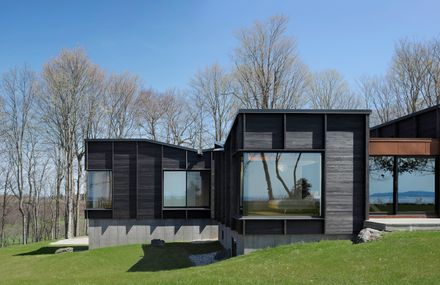
Michigan Lake House
PHOTOGRAPHS
Paul Warchol
LEAD ARCHITECTS
Arjun Desai, Katherine Chia
ENVELOPE CONSULTANT
James R. Gainfort Aia
MANUFACTURERS
C.R. Laurence, Appiani, B-K Lighting, Benjamin Moore, Colonial Bronze, Cooper Lighting, Edison Price Lighting, Elkay, Epco, FontanaArte, Forms + Surfaces, Grohe, Hafele, Hansgrohe, Kohler, Leucos, Marset, Marvel, Miele, Omnia Industries, +21
STRUCTURAL
Apex Engineering Corporation
CONTRACTOR
Easling Construction
MECHANICAL
Bayshore Engineering
LANDSCAPER
Darling Botanical Co.
LANDSCAPE ARCHITECT
Surface Design Inc.
LIGHTING
Christine Sciulli Light + Design
ARCHITECT OF RECORD
Environment Architects, Traverse City, MI
CUSTOM FURNITURE
Woodbine Custom Furniture & Cabinetry
CATEGORY
Houses
AV
Waara Technologies
CIVIL
Jozwiak Consulting Engineers
LOCATION
Leelanau County, United States
Text description provided by architect.
Perched on a woodland bluff overlooking Lake Michigan, this home, designed in collaboration with Environment Architects (AOR) of Traverse City, MI, is an assemblage of three offset structures that play off each other— the ‘gathering’ structure contains the living room, kitchen and a covered 'vista' seating terrace; the two 'sleeping' structures house the master bedroom suite and three children's bedrooms. A dining area breezeway connects all three structures.
The roofscape has gentle undulations that follow the movement of the natural terrain and make a playful reference to the vernacular architecture of nearby fishing villages.
At the southern end of the house, a 20 foot cantilevered roof extends over the 'vista' terrace, providing a protected, unobstructed view of Lake Michigan and the surrounding woodlands.
The resulting rhythm of exposed wood beams provides layers of asymmetrical vaults throughout the interiors.
Scuppers of the roof collect rainwater, allow for drainage, and assist with erosion control around the site. The home elegantly integrates geothermal heating into its design.
Studies of the prevailing winds determined window placement to take advantage of natural ventilation: there is no air-conditioning in the home.
The exterior of the house is clad in ‘shou sugi ban,' a traditional Japanese method of charring wood so it becomes rot resistant and bug resistant.
The charred texture and the modulation of deep facade members enhances the shadows across the facade as the sun rises and sets.
We reclaimed dying ash trees from the site and milled them down to be used as interior cabinetry, flooring, ceiling panels, trim work, and custom furniture throughout the house.
The interiors of the house embody the indigenous landscape that once thrived with old growth ash.
Landscape design strategies were closely tied to the design of the house. A tight palette of native vegetation highlights views while also managing storm water run-off.















